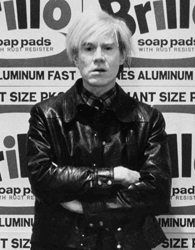Andy Warhol was nothing less than a character. His quirky art, astounding business sense and love of a good party made him one of the most influential personalities of his generation. From Pittsburgh to the notorious “Factory” where he entertained New York City’s young and hip, Warhol pursued fame and popularity nearly as intensely as he did art and filmmaking. But beneath the loud colors and vibrancy of his work, Warhol was shy and quiet, reportedly hiring look-alikes to speak for him at engagements.
Andy Warhol’s Early Days
Andrew Warhola was born in Pittsburgh, Pennsylvania, on August 6, 1928, the youngest of three sons born to Slovakian immigrants Julia and Ondrej Warhola. He displayed an early talent for drawing at the family home in industrial, Great Depression-era Pittsburgh.
It seems Warhol was never quite satisfied, even with his own name. While attending Pittsburgh’s Carnegie Institute of Technology (now Carnegie Mellon University), he tried calling himself “Andre” before settling on the friendlier “Andy,” and dropped the second “a” in “Warhola” to create his memorable last name.
Sources in this Story
- The Andy Warhol Family Album: Warhol’s Biography
- PBS: American Masters: Andy Warhol
- Museum of Modern Art: Andy Warhol
- Charlie Rose: Interview Magazine Celebrates Andy Warhol
- The New York Times: Andy Warhol, Pop Artist, Dies
Warhol’s Art
After graduating in 1945 with a Bachelor of Fine Arts degree in pictorial design, studying alongside greats like Balcomb Green and Samuel Rosenberg, Warhol moved to New York City to pursue commercial art. Success came rather quickly, and Glamour magazine featured his work in September 1949.
In the decade that followed, Warhol prospered, winning many awards from the Art Directors Club and the American Institute of Graphic Arts. In the late 1950s, Warhol traipsed through Europe and Asia, and began focusing on painting.
Warhol is credited with fathering Pop Art, a movement that still inspires artists today. His portraits of Campbell’s soup cans, Coca-Cola bottles and Hollywood stars like Marilyn Monroe made Warhol a world-renowned artist. He soon delved into sculpture and filmmaking, and surrounded himself with the young and hip in his New York City “Factory.” Holding an unabashed fascination with celebrity, Warhol famously remarked, “In the future everybody will be world famous for fifteen minutes.”
The Rest of the Story
On June 3, 1968, Warhol was shot by Valerie Solanas, a militant feminist and hanger-on at The Factory who was angered that Warhol had lost a script of hers. Warhol was pronounced dead at the hospital, but doctors managed to revive him.
Warhol’s life and art changed markedly after the shooting. He dissociated himself from The Factory scene and began creating art on commission for wealthy clients. He also founded Interview magazine to report “on all things avant garde, art, culture, music and fashion.”
Warhol died of complications after gall bladder surgery on February 22, 1987. In his obituary, The New York Times wrote, “Mr. Warhol’s keenest talents were for attracting publicity, for uttering the unforgettable quote and for finding the single visual image that would most shock and endure.”
The Andy Warhol Museum on the city of Pittsburgh’s North Shore is one of four of the city’s Carnegie Museums. The museum opened in 1994, and hosts a permanent collection of Warhol’s work, which has long provided “insights into contemporary art and popular culture.”
This story was originally written by Sarah Amandolare; it was updated July 7, 2017.











